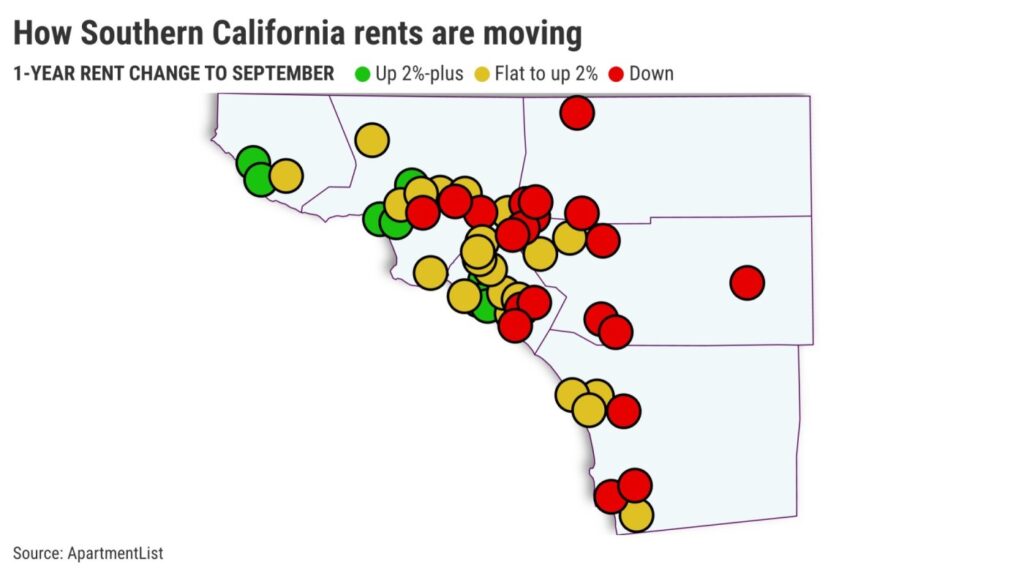
Finding rent discounts in Southern California has become increasingly challenging. Analysis of September rental data from ApartmentList, which surveyed 50 cities across Los Angeles, Orange, Riverside, San Bernardino, San Diego, and Ventura counties, reveals that tenant expectations for continued discounts are fading. Over the past year, the median rent across these cities experienced a modest increase of 0.4%, with 20 cities reporting declines.
This shift in rental trends contrasts sharply with the previous year’s data, where the median rent saw a 1% decrease, and 30 cities experienced price reductions. Notable fluctuations included a significant 4.1% drop in Laguna Niguel and a 4.4% increase in Santa Ana.
Several factors have contributed to the cooling of rent discounts in the region. The high cost of home ownership continues to deter families from purchasing homes, maintaining strong demand for rental properties. Furthermore, the recent completion of a modest new construction surge means landlords face fewer new units to fill. The impact of January’s wildfires in Los Angeles County has also significantly reduced housing supply, further amplifying demand. Areas closer to the fire zones are experiencing notably firmer pricing.
County-by-County Analysis of Rental Trends
Examining the data on a county level sheds light on how these trends vary across the region. The three counties most affected by the wildfires—Los Angeles, Ventura, and Orange—showed rent decreases in just six of the 30 cities tracked. By contrast, in the remaining counties of San Diego, Riverside, and San Bernardino, 14 out of 20 cities reported rent declines.
In Orange County, rents rose by 1.4% over the past year, reaching an average of $2,576 per month. This is a slight increase from a 0.2% gain the previous year. Notable extremes included a 4.4% increase in Santa Ana and a 4.1% decrease in Laguna Niguel.
Ventura County saw a 0.8% rise in rents, averaging $2,475 monthly, compared to a 0.7% increase in the prior year. The city of Ventura recorded a 3.6% gain, while Thousand Oaks experienced a slight decline of 0.3%.
In Los Angeles County, the average rent increased by 0.3% to $2,090. This change follows a 1.6% drop in the previous year. Here, Burbank saw a 2.2% increase, while West Covina faced a 1.5% decline.
San Diego County reported a slight decrease of 0.1% to an average rent of $2,278, down from a 2.9% decline the previous year. Rents in Vista increased by 1.9%, while Escondido saw a 1.3% drop.
Riverside County experienced a 0.9% decrease, with average rents at $1,925. The city of Riverside managed a 0.4% gain, but Temecula suffered a 3.6% decline. San Bernardino County showed a more significant drop of 1.4%, with an average rent of $1,773, where Ontario saw a 0.9% drop and Colton faced a 3% decline.
State and National Rental Trends
Statewide, California’s rental market reflects similar trends, with an overall increase of 1.3% to an average of $2,198 over the past year, compared to a 0.4% decrease in the prior period. This situation adds to the burden for many renters, as 27% of California tenants now spend more than half of their income on rent.
In contrast, the national picture indicates a slight decline, with U.S. rents falling 0.8% to an average of $1,394. This follows a 0.7% drop from the previous year, highlighting a divergence in trends between California and the rest of the country.
These evolving rental dynamics underscore the ongoing challenges faced by tenants in Southern California, where demand continues to outpace supply, leaving many renters to navigate a tightening market. Jonathan Lansner, a business columnist for the Southern California News Group, provides insights on these trends, emphasizing the broader implications for housing affordability in the region.






